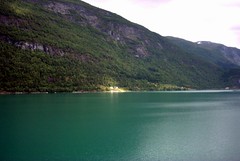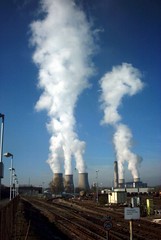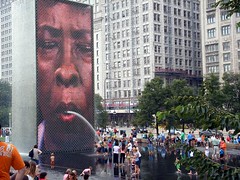July 27, 2011
Blaming victims, individuals or social structures?
 Blaming victims, individuals or social structures? - I pick apart some of the issues of in-group-out-group bias linked to the recent massacre in Norway and attempts by xenophobe politicians to distance themselves from them.
Blaming victims, individuals or social structures? - I pick apart some of the issues of in-group-out-group bias linked to the recent massacre in Norway and attempts by xenophobe politicians to distance themselves from them.
Breivik's actions are a pretty nasty demonstration of how far in-group-out-group biases can be taken. They are illustrative because his manifesto gives a somewhat clear image of how he ended up where he did. Being socially isolated (perhaps by a personality disorder) made nearly any social group his out-group. He could enhance his self-esteem by identifying with groups that he did not need to join in any social sense, such as being Norwegian, or by inventing even higher status groups where he automatically would be a member, like his "templars". (Obligatory Umberto Eco templar quote). Since practically anybody viewing this system from the outside threatened this fragile self-esteem, they became threatening. And since out-groups are seen as homogenous and their members driven by ideology rather than individual autonomy, their members become fair targets.
Of course, most people running this kind of mental program never go very far. Most end up as bitter Internet trolls, at most. There are other factors needed to turn someone into a killer. But as I argue in my ethics essay, the real threat does not come from individual killers but institutionalized bias against out-groups. This is where the enhanced power of a group (thanks to economies of scale and power over formal social structures) allows the bias to do real damage on a far larger scale, and the diffusion of responsibility makes individually not dangerous members into killers.
I do not fear individual terrorists, I fear biased and hateful institutions. Their members are diverse and autonomous, but they become correlated in a harmful way.
July 11, 2011
Quantitative progress
I have a post over on KurzweilAI about quantitative measures of technological progress.
July 07, 2011
The science of staying cool
 It is a warm day in Stockholm, and I noticed a couple using a black umbrella as a parasol. Is that a good idea?
It is a warm day in Stockholm, and I noticed a couple using a black umbrella as a parasol. Is that a good idea?
Let's assume the umbrella surface is perfectly black, absorbing all sunlight. Then it will heat up and re-radiate the energy as infra-red. But since it is thin, it will radiate it from both sides. So the total energy flux on the underside will be half the incident flux - the umbrella helps, but to a first approximation it is only half as good as avoiding the sunlight or having a perfectly reflecting parasol.
[See comment by Ralph Hartley below]
Doing the math: a parasol with albedo a, subject to an incident flux F Watts/m^2 and with emissivity e and s as the Stefan-Boltzman constant, has the following energy balance relation: aF = 2esT^4. So the equlibrium temperature will be T = (aF/2es)^0.25. For Swedish sunlight I would guess F is at best 200 W/m^2, a is between 0.1 (umbrella) and 0.7 (parasol), emissivity is likely pretty high in both cases, so I guess 0.9. That gives an equilibrium temperature of 118 and 192 Kelvin, respectively. Far lower than the freezing point! What gives?
The answer is of course that radiation is just part of how heat gets transferred on a summer day, and that I also neglected the heat emissions from the surroundings. There is also heat conduction, convection carried heated air away, and evaporative cooling (when we sweat). Digressing from the umbrella/parasol question, how can we keep cool most efficiently?
Air has a low thermal conductivity (0.025 W/mK). Getting rid of excess heat from your body solely by conduction is hard - a temperature difference of a few degrees between you and the world over a distance of 0.1 meters (the rough depth of our body heat cloud) leads to a puny flow of just some tenths of a Watt. We generate up to 100 Watts just by being warm blooded, so this doesn't do much.
 Convection is much better. Air has an overall heat transfer coefficient (which includes convection and conduction) of 10 to 100 W/(m^2K). Humans have a surface area of around 2 m^2, and for a 1 degree temperature difference the heat flow becomes between 20 to 200 Watts - definitely enough to keep us cool. This is of course also the reason for clothing and hair: even the 16 degree difference between a 21 C office and a 37 C human could in principle cool us at a rate much bigger than we can heat ourselves. When the convection is pretty mild (like around humans) the effective coefficient also becomes lower. It can be increased a lot by moving the air around, for example by a fan.
Convection is much better. Air has an overall heat transfer coefficient (which includes convection and conduction) of 10 to 100 W/(m^2K). Humans have a surface area of around 2 m^2, and for a 1 degree temperature difference the heat flow becomes between 20 to 200 Watts - definitely enough to keep us cool. This is of course also the reason for clothing and hair: even the 16 degree difference between a 21 C office and a 37 C human could in principle cool us at a rate much bigger than we can heat ourselves. When the convection is pretty mild (like around humans) the effective coefficient also becomes lower. It can be increased a lot by moving the air around, for example by a fan.
Are hand fans useful? On one hand they cool us, but we need to do some extra work too. I estimate that waving a fan around moves a few liters of air per second, moving them around 0.3 meters using a force of perhaps 1 Newtons. The total work is 0.3*1 = 0.3 Watt. The cooling effect likely jumps the effective heat transfer by a factor of 10 or so over an area of (say) 0.1 m^2. That is worth at least a Watt per degree of temperature difference, and probably much more. So fans are worth it.
 Of course the great cooling effect is from perspiration. When sweat evaporates the latent heat of evaporation has to be supplied, cooling the body. A litre of sweat per day (which I assume is typical for a warm day) corresponds to around 2256 kJ of energy per day, or 26 Watts. That is pretty decent and can be scaled up by sweating more (at least if the air is dry enough - there are some complications in evaporation).
Of course the great cooling effect is from perspiration. When sweat evaporates the latent heat of evaporation has to be supplied, cooling the body. A litre of sweat per day (which I assume is typical for a warm day) corresponds to around 2256 kJ of energy per day, or 26 Watts. That is pretty decent and can be scaled up by sweating more (at least if the air is dry enough - there are some complications in evaporation).
If you can get water externally you not only can get wet without loosing water yourself, but it also is an excellent thermal conductor and convector. Even water at ambient temperature will tend to cool, unless it is higher than your body temperature.
What about drinking a cold drink? An average weight 80 kg person drinking a 0.1 liters of ~0 C ice cold lemonade needs to supply 0.1 * 4.2 kJ * 37 = 15.5 kJ. That is around 155 seconds of 100 W metabolism. If the person were a perfectly mixed liquid mixing with the drink, it would lower their body temperature from 37 C to 36.95 C. So the cooling effect of a drink is likely more due to more liquid for sweating, and sitting in the shade drinking it rather than the temperature of the drink itself.
[Comment by Ralph Hartley:
While the sun's rays are nearly parallel, the radiation from the umbrella is nearly uniform, much of it will miss the person underneath.The actual amount of heat reaching the user depends on how high the umbrella is held. Only if it were very large relative to the distance would your factor of 2 be correct. For a large distances it is proportional to A/r^2 (with a constant involving 2PI?), until the umbrella is too far away to completely cover the sun's disk.
Consider an umbrella made of bumpy glass, which doesn't absorb or reflect any light at all, but uniformly scatters the rays as they pass through. It would still cast a shadow (surrounded by a bright ring). It would be half as good as a black umbrella, but still much better than nothing.
This is a good point, although I think normal umbrellas cover a significant part of the sky of the holder, making them receive much of the randomized radiation. But it is true - and rather intriguing - that a parasol of frosted glass might be as good as an umbrella for keeping cool. ]
July 04, 2011
Ban the beets?
 The hot new performance-enhancing drug is...beetroot juice!? (original paper)
The hot new performance-enhancing drug is...beetroot juice!? (original paper)
Nitrates in food reduces the oxygen cost of some forms of exercise and improves high-intensity exercise tolerance. So the researchers gave half a litre of beetroot juice (which contains around 6.2 mmol of nitrate) or a nitrate depleted placebo to club-level competitive cyclists. The nitrate got converted into nitrite in the blood stream, reduced systolic blood pressure, and produced better cycling performance when compared to placebo. On a 16.1 race beet juice reduced the total time by 2.7% - not much, but presumably enough to matter in a competition.
In any case, this is fun for doping discussions. Should we ban athletes from quaffing beet juice?
The typical arguments against doping are that they are unhealthy, unfair and against the spirit of sports.
The health side seems to be pretty safe here: beet juice does not look like a major health danger. The amount used was 4-12 times greater than the typical daily dietary nitrate intake in the United States, but presumably not too hard to ingest. It looks like it is pretty safe, but it could perhaps turn out that the wrong diet or intestinal flora produces nitrosamines that in turn could give you cancer. But compared to other environmental factors (after all, these are people swooshing around very fast on roads!) that risk is likely pretty small, plus the added vegetable intake might counter that.
It is hard to argue that it is unfair to non-juice drinkers since they could presumably drink it too - it is not expensive or hard to come by. Some (like me) may not like the taste or the side effect of coloured urine, but this seems to be a weak anti-doping argument: presumably many athletes don't like spandex either, yet trying to ban it from competitions where it helps performance because their aesthetic judgements is a non-starter.
And drinking healthy fruit juice to get ready for competition seems to be so close to the spirit of sport that it is almost parody. Maybe drinking juice knowing the nitrate will turn into endurance-improving nitrite is the key difference - but clearly people preparing for competition already eat finely tuned meals or food they just think will help them. Would knowing the causal link between carbohydrates and energy metabolism make spaghetti inadmissible as a pre-marathon meal? It seems absurd. If the 'spirit of sports' depends on people doing sport in a 'natural' way without knowing about physiology, biomechanics and nutrition, then it has been lost a long time ago.
So my prediction is that next Tour de France 10-14% of the urine tests will be red.